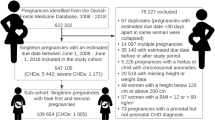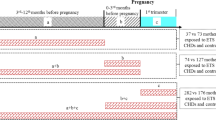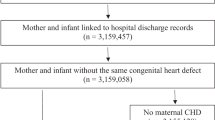Abstract
Background:
Limited studies have evaluated the risk factors for congenital heart defects (CHDs) in China and compared them for different types of CHDs. This study examined risk factors between isolated and multiple CHDs as well as among CHDs subtypes in Guangdong, Southern China.
Methods:
This population-based case–control study included 4,034 pairs of case and control infants enrolled in the Guangdong Registry of CHD study, 2004–2013. Multivariate logistic regression was used to compute adjusted odds ratios (ORs) while simultaneously controlling for confounders.
Results:
Multiple maternal environmental exposures, including living in newly renovated rooms, residential proximity to main traffic, paternal smoking, and maternal occupation as manual worker, were significantly associated with CHDs with ORs ranging 1.30–9.43. Maternal perinatal diseases (including maternal fever, diabetes, influenza, and threatened abortion), maternal medication use (antibiotic use), advanced maternal age, low socioeconomic status, and paternal alcohol intake were also significantly associated with CHDs, with ORs ranging 1.60–3.96. Isolated CHDs and multiple defects have different profiles of risk factors, while subtype of CHD shares common risk factors.
Conclusion:
These results suggest that maternal environmental exposures/occupation and perinatal diseases/medication use were dominant risk factors associated with CHDs in Southern China. Isolated and multiple CHDs may have different etiologic factors.
Similar content being viewed by others
Log in or create a free account to read this content
Gain free access to this article, as well as selected content from this journal and more on nature.com
or
References
Donofrio MT, Moon-Grady AJ, Hornberger LK, et al.; American Heart Association Adults With Congenital Heart Disease Joint Committee of the Council on Cardiovascular Disease in the Young and Council on Clinical Cardiology, Council on Cardiovascular Surgery and Anesthesia, and Council on Cardiovascular and Stroke Nursing. Diagnosis and treatment of fetal cardiac disease: a scientific statement from the American Heart Association. Circulation 2014;129:2183–242.
Jenkins KJ, Correa A, Feinstein JA, et al.; American Heart Association Council on Cardiovascular Disease in the Young. Noninherited risk factors and congenital cardiovascular defects: current knowledge: a scientific statement from the American Heart Association Council on Cardiovascular Disease in the Young: endorsed by the American Academy of Pediatrics. Circulation 2007;115:2995–3014.
Botto LD, Lin AE, Riehle-Colarusso T, Malik S, Correa A ; National Birth Defects Prevention Study. Seeking causes: classifying and evaluating congenital heart defects in etiologic studies. Birth Defects Res A Clin Mol Teratol 2007;79:714–27.
Gorini F, Chiappa E, Gargani L, Picano E. Potential effects of environmental chemical contamination in congenital heart disease. Pediatr Cardiol 2014;35:559–68.
Gilboa SM, Desrosiers TA, Lawson C, et al.; National Birth Defects Prevention Study. Association between maternal occupational exposure to organic solvents and congenital heart defects, National Birth Defects Prevention Study, 1997-2002. Occup Environ Med 2012;69:628–35.
Shaw GM, Nelson V, Iovannisci DM, Finnell RH, Lammer EJ. Maternal occupational chemical exposures and biotransformation genotypes as risk factors for selected congenital anomalies. Am J Epidemiol 2003;157:475–84.
Ferencz C, Correa-Villasenor A, Loffredo CA, eds. Genetic and Environmental Risk Factors of Major Cardiovascular Malformations: The Baltimore-Washington Infant Study: 1981–1989. Armonk, NY: Futura Publishing Co., 1997.
Liu Z, Li X, Li N, et al. Association between maternal exposure to housing renovation and offspring with congenital heart disease: a multi-hospital case-control study. Environ Health 2013;12:25.
Drake VJ, Koprowski SL, Lough J, Hu N, Smith SM. Trichloroethylene exposure during cardiac valvuloseptal morphogenesis alters cushion formation and cardiac hemodynamics in the avian embryo. Environ Health Perspect 2006;114:842–7.
Watson RE, Jacobson CF, Williams AL, Howard WB, DeSesso JM. Trichloroethylene-contaminated drinking water and congenital heart defects: a critical analysis of the literature. Reprod Toxicol 2006;21:117–47.
Yorifuji T, Naruse H, Kashima S, et al. Residential proximity to major roads and placenta/birth weight ratio. Sci Total Environ 2012;414:98–102.
Ritz B, Yu F, Fruin S, Chapa G, Shaw GM, Harris JA. Ambient air pollution and risk of birth defects in Southern California. Am J Epidemiol 2002;155:17–25.
Gilboa SM, Mendola P, Olshan AF, et al. Relation between ambient air quality and selected birth defects, seven county study, Texas, 1997-2000. Am J Epidemiol 2005;162:238–52.
Yorifuji T, Naruse H, Kashima S, et al. Residential proximity to major roads and adverse birth outcomes: a hospital-based study. Environ Health 2013;12:34.
Jason MH. Oxidative stress as a mechanism of teratogenesis. Birth Defects Research (Part C) 2006;78:293–307.
Kannan S, Misra DP, Dvonch JT, Krishnakumar A. Exposures to airborne particulate matter and adverse perinatal outcomes: a biologically plausible mechanistic framework for exploring potential effect modification by nutrition. Environ Health Perspect 2006;114:1636–42.
Hernández-Díaz S, Werler MM, Walker AM, Mitchell AA. Folic acid antagonists during pregnancy and the risk of birth defects. N Engl J Med 2000;343:1608–14.
Czeizel AE, Rockenbauer M, Sørensen HT, Olsen J. The teratogenic risk of trimethoprim-sulfonamides: a population based case-control study. Reprod Toxicol 2001;15:637–46.
Andersen JT, Petersen M, Jimenez-Solem E, et al. Trimethoprim use prior to pregnancy and the risk of congenital malformation: a register-based nationwide cohort study. Obstet Gynecol Int 2013;2013:364526.
Feng Y, Wang S, Chen R, Tong X, Wu Z, Mo X. Maternal folic acid supplementation and the risk of congenital heart defects in offspring: a meta-analysis of epidemiological observational studies. Sci Rep 2015;5:8506.
Czeizel AE, Rockenbauer M, Olsen J, Sørensen HT. Oral phenoxymethylpenicillin treatment during pregnancy. Results of a population-based Hungarian case-control study. Arch Gynecol Obstet 2000;263:178–81.
Dencker BB, Larsen H, Jensen ES, Schønheyder HC, Nielsen GL, Sørensen HT. Birth outcome of 1886 pregnancies after exposure to phenoxymethylpenicillin in utero. Clin Microbiol Infect 2002;8:196–201.
Czeizel AE, Sørensen HT, Rockenbauer M, Olsen J. A population-based case-control teratologic study of nalidixic acid. Int J Gynaecol Obstet 2001;73:221–8.
Wang J, Wang P, Wang X, Zheng Y, Xiao Y. Use and prescription of antibiotics in primary health care settings in China. JAMA Intern Med 2014;174:1914–20.
Lv B, Zhou Z, Xu G, et al. Knowledge, attitudes and practices concerning self-medication with antibiotics among university students in western China. Trop Med Int Health 2014;19:769–79.
Botto LD, Panichello JD, Browne ML, et al.; National Birth Defects Prevention Study. Congenital heart defects after maternal fever. Am J Obstet Gynecol 2014;210:359.e1–359.e11.
Botto LD, Erickson JD, Mulinare J, Lynberg MC, Liu Y. Maternal fever, multivitamin use, and selected birth defects: evidence of interaction? Epidemiology 2002;13:485–8.
Adams MM, Mulinare J, Dooley K. Risk factors for conotruncal cardiac defects in Atlanta. J Am Coll Cardiol 1989;14:432–42.
Botto LD, Lynberg MC, Erickson JD. Congenital heart defects, maternal febrile illness, and multivitamin use: a population-based study. Epidemiology 2001;12:485–90.
Edwards MJ. Apoptosis, the heat shock response, hyperthermia, birth defects, disease and cancer. Where are the common links? Cell Stress Chaperones 1998;3:213–20.
Roulston A, Marcellus RC, Branton PE. Viruses and apoptosis. Annu Rev Microbiol 1999;53:577–628.
Yassaee F, Shekarriz-Foumani R, Afsari S, Fallahian M. The effect of progesterone suppositories on threatened abortion: a randomized clinical trial. J Reprod Infertil 2014;15:147–51.
Li L, Dou L, Leung PC, Wang CC. Chinese herbal medicines for threatened miscarriage. Cochrane Database Syst Rev 2012;5:CD008510.
Miller A, Riehle-Colarusso T, Siffel C, Frías JL, Correa A. Maternal age and prevalence of isolated congenital heart defects in an urban area of the United States. Am J Med Genet A 2011;155A:2137–45.
Yang J, Carmichael SL, Canfield M, Song J, Shaw GM ; National Birth Defects Prevention Study. Socioeconomic status in relation to selected birth defects in a large multicentered US case-control study. Am J Epidemiol 2008;167:145–54.
Abel E. Paternal contribution to fetal alcohol syndrome. Addict Biol 2004;9:127–33; discussion 135–6.
Zhang QJ, Liu ZP. Histone methylations in heart development, congenital and adult heart diseases. Epigenomics 2015;7:321–30.
Vallaster M, Vallaster CD, Wu SM. Epigenetic mechanisms in cardiac development and disease. Acta Biochim Biophys Sin (Shanghai) 2012;44:92–102.
Acknowledgements
We thank all the collaborated hospitals for their great efforts in screening/diagnosing CHD and interviewing the studied population (hospital names are listed in the Supplementary Data online).
Author information
Authors and Affiliations
Corresponding author
Supplementary information
Supplementary Data
(DOCX 18 kb)
PowerPoint slides
Rights and permissions
About this article
Cite this article
Ou, Y., Mai, J., Zhuang, J. et al. Risk factors of different congenital heart defects in Guangdong, China. Pediatr Res 79, 549–558 (2016). https://doi.org/10.1038/pr.2015.264
Received:
Accepted:
Published:
Issue date:
DOI: https://doi.org/10.1038/pr.2015.264
This article is cited by
-
Lower Socioeconomic Status is Associated with an Increased Incidence and Spectrum of Major Congenital Heart Disease and Associated Extracardiac Pathology
Pediatric Cardiology (2024)
-
Maternal periconceptional environmental exposure and offspring with congenital heart disease: a case–control study in Guangzhou, China
BMC Pregnancy and Childbirth (2023)
-
Associations between ambient heat exposure early in pregnancy and risk of congenital heart defects: a large population-based study
Environmental Science and Pollution Research (2022)
-
Maternal exposure to life events during pregnancy and congenital heart disease in offspring: a case-control study in a Chinese population
BMC Pregnancy and Childbirth (2021)
-
Neighbourhood maternal socioeconomic status indicators and risk of congenital heart disease
BMC Pregnancy and Childbirth (2021)



